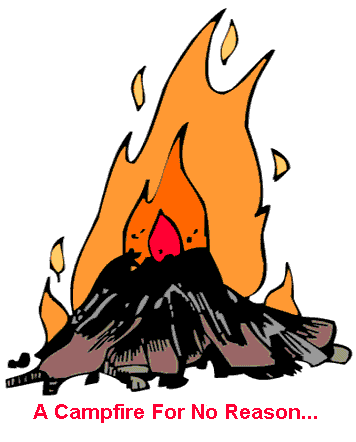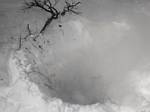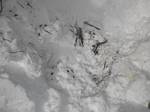Roger J. Wendell
Defending 3.8 Billion Years of Organic EvolutionSM



|
Walking Ever So Softly (Low Impact Techniques for the Backcountry)
by Roger J. Wendell, Rocky Mountain Chapter Outings Chair |

|
Click Here for my YouTube "Only YOU can prevent campfires!" video... |

|
Click Here for the Ten Essentials - Don't leave home without 'em! |
As a young boy in the 60s, hiking and camping was a low-tech, high-impact affair. Back then cutting switchbacks, felling small trees (or large branches) for firewood, and washing in the stream were standard practices. Now, with diminishing wilderness and a burgeoning human population, such disregard for nature has begun to take its toll. So, here are a few rules I try to follow in an effort to leave as little trace as possible:
In summary, there isn't too much that's mysterious about low impact techniques. Entering the land with a healthy respect for the environment can provide you with the incentive to leave as little trace as possible. By walking ever so softly, we can do our part to preserve that special place called wilderness.
©Copyright 1998 Roger J. Wendell


|
On Sunday morning, February 17, 2008 I was backcountry skiing up Stevens Gulch near the 14,000 foot peaks of Grays and Torreys in Colorado. Although a bit overcast the air was crisp and clean with fresh snow all about me. However, about a mile before encountering him, I could smell the smoke from a fire built by another skier. There was nobody else in the area, for miles around, so I was a bit concerned my new-to-be-found fire making friend was in some kind of trouble. Nope! Further up the gulch I finally discovered a man, probably in his mid 40s, standing next to a snow pit with a fire burning in it. When I questioned him he assured me all was okay and that he really didn't need the fire for anything other than "comfort" - despite the fact he hadn't spent the night there nor was he stopping to cook anything or dry out his clothing.
He assured me the fire wasn't a hazard with so much snow around but wasn't too pleased when I noted he had stripped a lot of the lower branches of the adjacent trees when he created his "comfort" stop. I proceeded up Stevens Gulch, to just above timberline, and then skied back down to the mystery "comfort" station - I had been away from it for at least half an hour. When I arrived back my newly found friend was long-gone, having skied back down the gulch towards his parked car at Interstate 70. Sadly, his fire was still fully ablaze and there was nobody else around but me! After taking a short video and these photographs I made sure the fire was completely out and I, too, skied back to my own car about an hour downhill from the "comfort" fire. Although I've seen campfire scars and trees stripped of their lower branches all over the American west I'd never seen a fire as stupid as this one - apparently built for nothing more than watching it snap and crackle in broad daylight - what a goofy waste!
February 17, 2008 - Colorado |
 An idiot's fire built for no reason |
 Roger throws snow on the fire... |
 The fire is completely out! |
|

Leave No Trace Principles
(From the CMC's trip leader manual and the www.LNT.org)
- Stay on designated trails and don't cut switchbacks. If you must go off-trail, spread out to minimize impact.
- Walk on durable surfaces whenever possible. Avoid creating wider trails or multiple trails by walking through puddles on the trail, not around them.
- When walking on open areas where there is no trail, spread out unless it is necessary to walk single file (e.g., in thick brush and to maintain group proximity)
- Use the most stable route, avoiding loose scree unless it offers the safest path.
- Conduct bathroom stops at least two hundred feet from bodies of water. Bury feces in a cathole 6 inches deep, mix with the soil, and cover with soil (Some places require you to carry out feces).
- Pack out toilet paper in plastic bags. Carry out all toilet paper and personal hygiene products, even if they say they are biodegradable (wildlife may dig them up before they degrade).
- Pack out biodegradable food; don't throw it on the ground.
- Rest on rocks, not on vegetation.
- Leave what you find, including flowers and berries.
- Leave nothing behind, even bio-degradable garbage. Lunch garbage can bring new species to an area that is not indigenous and it can provide human food to animals that should not rely on it.
- Beware of the impact of noise on wildlife. Respect wildlife Do not feed animals and don't approach wildlife.
- If camping overnight and there are established sites, use them. Otherwise choose area that has least impact and return it to its natural state.
- Camp at least 200 feet from water and from trail.
- Store your food and trash securely so wildlife cannot get it.
- If you must have a fire, use an existing fire ring if there is one. Gather dead wood from the ground (do not snap branches off trees). Make sure the fire is completely extinguished.

Links:
|
|
| Warning! Climbing, mountaineering, and backcountry skiing are dangerous and can seriously injure or kill you. By further exploring this web site you acknowledge that the information presented here may be out of date or incorrect, and you agree not to hold the author responsible for any damages, injuries, or death arising from any use of this resource. Please thoroughly investigate any mountain before attempting to climb it, and do not substitute this web site for experience, training, and recognizing your limitations! |

 Back to Roger J. Wendell's Home Page...
Back to Roger J. Wendell's Home Page...
Abbey |
About |
Blog |
Contacting
Me |
Copyright |
Disclaimer |
Donate |
Guest
Book |
Home |
Links |
Site
Index |
Solutions |
Terms,
Conditions
and
Fair
Use |
What's
Changed
or
New?
Copyright
© 1955 -